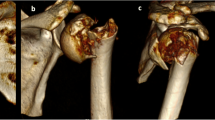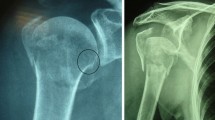Abstract
Introduction
Subtrochanteric fractures of femur remain most challenging injuries faced by orthopaedic surgeons. The implant choice shifted from extra medullary to intramedullary nails over the last two decades. Effort to achieve anatomical reduction before nail insertion for better outcomes has been emphasized well in literature. We reviewed various surgical techniques for reduction of fracture in more biological way that can be used to overcome the deforming forces of the muscles acting on fracture fragments.
Conclusion
Regardless of the closed vs open reduction for subtrochanteric fracture fixation, the key point to reduce the risk of complications is quality of reduction of fracture. This article highlights specific strategies to achieve reliable, efficient and desired outcomes when using intramedullary nails for subtrochanteric fractures.








Similar content being viewed by others
References
Herscovici D Jr, Pistel WL, Sanders RW (2000) Evaluation and treatment of high subtrochanteric femur fractures. Am J Orthop (belle Mead Nj) 29(9):27–33
Parker MJ, Dutta BK, Sivaji C, Pryor GA (1997) Subtrochanteric fractures of the femur. Injury 28(2):91–95
Bedi A, Toan Le T (2004) Subtrochanteric femur fractures. Orthop Clin N Am 35(4):473–483
Reynders PA, Stuyck J, Rogers RKL, Broos PLO (1993) Subtrochanteric fractures of the femur treated with the Zickel nail. Injury 24(2):93–96
Borens O, Wettstein M, Kombot C, Chevalley F, Mouhsine E, Garofalo R (2004) Long gamma nail in the treatment of subtrochanteric fractures. Arch Orthop Trauma Surg 124(7):443–447
Liang K, Xiang Z, Chen S, Cen S, Zhong G, Yi M, Huang F (2012) Folded free vascularized fibular grafts for the treatment of subtrochanteric fractures complicated with segmental bone defects. J Trauma Acute Care Surg 72(5):1404–1410
Ma CH, Tu YK, Yu SW, Yen CY, Yeh JH, Wu CH (2010) Reverse LISS plates for unstable proximal femoral fractures. Injury 41(8):827–833. https://doi.org/10.1016/j.injury.2010.03.028
Kanthimathi B, Narayanan VL (2012) Early complications in proximal femoral nailing done for treatment of subtrochanteric fractures. Malays Orthop J 6(1):25–29. https://doi.org/10.5704/MOJ.1203.009
Taitsman LA, Lynch JR, Agel J, Barei DP, Nork SE (2009) Risk factors for femoral nonunion after femoral shaft fracture. J Trauma 67(6):1389–1392
Joglekar SB, Lindvall EM, Martirosian A (2015) Contemporary management of subtrochanteric fractures. Orthop Clin N Am 46(1):21–35
Vaishya R, Agarwal AK, Gupta N, Vijay V (2016) Reversed distal femoral locking plate for failed proximal femoral nail with non-union of proximal femoral fractures. Int Orthop 40(8):1709–1715. https://doi.org/10.1007/s00264-015-3002-5
Kregor PJ, Obremskey WT, Kreder HJ et al (2005) Unstable pertrochanteric femoral fractures. J Orthop Trauma 19(1):63–66
Sangwan SS, Kundu ZS, Siwach RC, Marya KM, Yadav V, Devgan A (2004) Role of modified Kuntscher’s nail in management of subtrochanteric fractures of femur. Indian J Orthop 38(2):100–103
Johnson KD, Tencer AF, Sherman MC (1987) Biomechanical factors affecting fracture stability and femoral bursting in closed intramedullary nailing of femoral shaft fractures, with illustrative case presentations. J Orthop Trauma 1(1):1–11
Ostrum RF, Marcantonio A, Marburger R (2005) A critical analysis of the eccentric starting point for trochanteric intramedullary femoral nailing. J Orthop Trauma 19(10):681–686. https://doi.org/10.1097/01.bot.0000184145.75201.1b
Streubel PN, Wong AH, Ricci WM, Gardner MJ (2011) Is there a standard trochanteric entry site for nailing of subtrochanteric femur fractures? J Orthop Trauma 25(4):202–207
Tornetta P 3rd, Tiburzi D (2000) Antegrade or retrograde reamed femoral nailing. A prospective, randomized trial. J Bone Joint Surg (Br) 82:652–654
Yoon RS, Donegan DJ, Liporace FA (2015) Reducing subtrochanteric femur fractures: tips and tricks, do’s and don’ts. J Orthop Trauma 29(4):28–33
Shukla S, Johnston P, Ahmad MA, Wynn-Jones H, Patel AD, Walton NP (2007) Outcome of traumatic subtrochanteric femoral fractures fixed using cephalo-medullary nails. Injury 38(11):1286–1293
Farrar MJ, Binns MS (1996) Percutaneous reduction for closed nailing of femoral shaft fractures. J R Coll Surg Edinb 41(4):267–268
Kokkalis ZT, Mavrogenis AF, Ntourantonis DI, Igoumenou VG, Antoniadou T (2019) Reduction techniques for difficult subtrochanteric fractures. Eur J Orthop Surg Traumatol 29(1):197–204
Stedtfeld HW, Mittlmeier T, Landgraf P (2004) The logic and clinical applications of blocking screws. J Bone Joint Surg Am 86-A(2):17–25
Chang SM, Zhang YQ, Du SC, MaZ HSJ, Yao XZ, Xiong WF (2019) Anteromedial cortical support reduction in unstable pertrochanteric fractures: a comparison of intra-operative fluoroscopy and post-operative three dimensional computerised tomography reconstruction. Int Orthop 42(1):183–189. https://doi.org/10.1007/s00264-017-3623-y
Kim JW, Park KC, Oh JK, Oh CW, Yoon YC, Chang HW (2014) Percutaneous cerclage wiring followed by intramedullary nailing for subtrochanteric femoral fractures: a technical note with clinical results. Arch Orthop Trauma Surg 134(9):1227–1235
Anglen JO, Weinstein JN (2008) American Board of Orthopaedic Surgery Research Committee: nail or plate fixation of intertrochanteric hip fractures: changing pattern of practice. A review of the American Board of Orthopaedic Surgery Database. J Bone Joint Surg Am 90(4):700–707
Alberghina F, Andreacchio A, Cravino M, Paonessa M, Canavese F (2019) Extra-articular proximal femur fractures in children and adolescents treated by elastic stable intramedullary nailing. Int Orthop. https://doi.org/10.1007/s00264-019-04379-x
Alhammoud A, Maaz B, Alhaneedi GA, Alnouri M (2019) External fixation for primary and definitive management of open long bone fractures: the Syrian war experience. Int Orthop. https://doi.org/10.1007/s00264-019-04314-0
Iwakura T, Niikura T, Lee SY, Sakai Y, Nishida K, Kuroda R, Kurosaka M (2013) Breakage of a third generation gamma nail: a case report and review of the literature. Case Rep Orthop. id. 172352. https://doi.org/10.1155/2013/172352
Gallagher CA, Jones CW, Kimmel L, Wylde C, Osbrough A, Bulsara M, Hird K, Yates P (2019) Osteoarthritis is associated with increased failure of proximal femoral fracture fixation. Int Orthop 43(5):1223–1230. https://doi.org/10.1007/s00264-018-4014-8
Chang SM, Zhang YQ, Ma Z, Li Q, Dargel J, Eysel P (2015) Fracture reduction with positive medial cortical support: a key element in stability reconstruction for the unstable pertrochanteric hip fractures. Arch Orthop Trauma Surg 135(6):811–818
Chen W, Jing Y, Lv H, Wang J, Hou Z, Zhang Y (2016) Displaced femoral shaft fractures treated by antegrade nailing with the assistance of an intramedullary reduction device. Int Orthop 40(8):1735–1739. https://doi.org/10.1007/s00264-015-3036-8
Miedel R, Törnkvist H, Ponzer S, Söderqvist A, Tidermark J (2011) Musculoskeletal function and quality of life in elderly patients after a subtrochanteric femoral fracture treated with a cephalomedullary nail. J Orthop Trauma 25(4):208–213
Krappinger D, Wolf B, Dammerer D, Thaler M, Schwendinger P, Lindtner RA (2019) Risk factors for nonunion after intramedullary nailing of subtrochanteric femoral fractures. Arch Orthop Trauma Surg 139(6):769–777. https://doi.org/10.1007/s00402-019-03131-9
Afsari A, Liporace F, Lindvall E, Infante A Jr, Sagi HC, Haidukewych GJ (2009) Clamp-assisted reduction of high subtrochanteric fractures of the femur. J Bone Joint Surg Am 91:1913–1918
Park J, Yang KH (2010) Correction of malalignment in proximal femoral nailing—reduction technique of displaced proximal fragment. Injury. 41:634–638
Seyhan M, Unay K, Sener N (2012) Comparison of reduction methods in intramedullary nailing of subtrochanteric femoral fractures. Acta Orthop Traumatol Turc 46(2):113–119
Liu Y, Zheng Y, Shen Z, Wang S, Wei X, Gu X, Zhan H, Kuang Y (2017) Interlocking intramedullary nail fixation with additional bone grafting from trochanter via a femoral hollow trephine in the treatment of femoral shaft fractures: design and clinical application. Int Orthop 41(2):397–402. https://doi.org/10.1007/s00264-016-3207-2
Author information
Authors and Affiliations
Corresponding author
Ethics declarations
Conflict of interest
The authors declare that they have no conflicts of interest.
Additional information
Publisher’s note
Springer Nature remains neutral with regard to jurisdictional claims in published maps and institutional affiliations.
Rights and permissions
About this article
Cite this article
Kasha, S., Yalamanchili, R.K. Management of subtrochanteric fractures by nail osteosynthesis: a review of tips and tricks. International Orthopaedics (SICOT) 44, 645–653 (2020). https://doi.org/10.1007/s00264-019-04404-z
Received:
Accepted:
Published:
Issue Date:
DOI: https://doi.org/10.1007/s00264-019-04404-z




